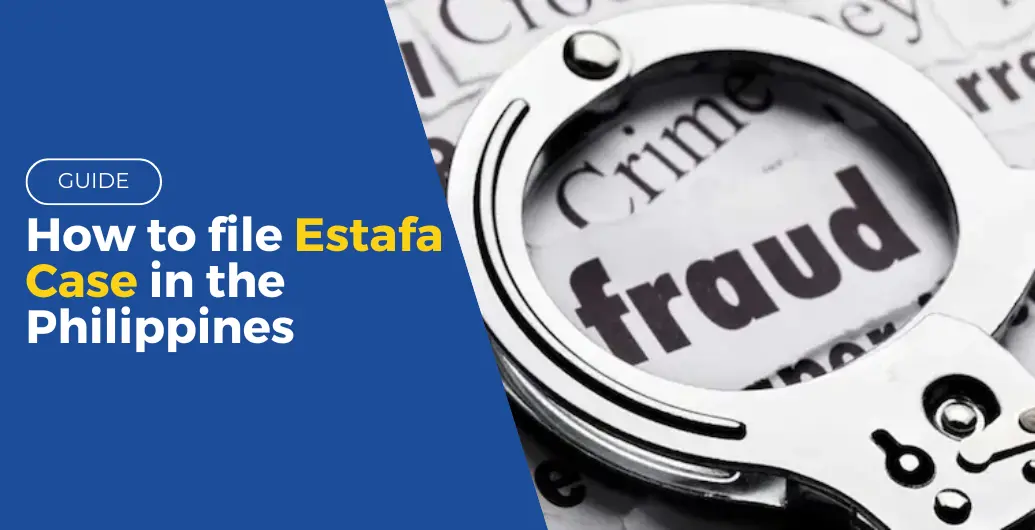Estimated reading time: 5 minutes
Filing an estafa case in the Philippines requires understanding the legal process and requirements. Hence, this guide will explain how to file estafa case in the Philippines, as well as the necessary evidence, and how to meet the estafa case requirements for filing. Moreover, by understanding the estafa Philippine law, you can better navigate the legal system and learn how to win an estafa case.
Table of contents
What is considered Estafa?
Swindling or estafa occurs when someone defrauds another using unfaithfulness or abuse of confidence. Estafa involves false pretenses or fraudulent acts committed before or during the fraud. According to Article 315 of the Revised Penal Code, estafa can be committed in several ways.
Unfaithfulness or Abuse of Confidence
- Altering the quality, quantity, or substance of a contract’s subject matter.
- Misappropriating or converting another’s money, goods, or personal property.
- Denying someone access to their property.
- Taking advantage of a signature in blank.
Deceit or Fraudulent Acts
- Using a fictitious identity to deceive.
- Altering the quality, fineness, or weight of items related to art or business.
- Issuing unfunded or postdated checks.
- Using services from hotels, restaurants, inns, etc., without paying.
Fraudulent Means
- Inducing someone, through deceit, to sign a document.
- Using fraudulent practices to win a gambling game.
- Removing, concealing, or destroying court records, office files, documents, or other papers.
To understand how to file estafa case, it is essential to know the estafa case requirements in the Philippines.
Requirements to File an Estafa Case
To file an estafa case in the Philippines, the complainant must meet several requirements. The key elements include:
- Deceit or Fraudulent Act: The accused must have committed deceit or a fraudulent act, misleading another person to their detriment.
- Damage or Prejudice: The complainant must show damage or prejudice, usually involving financial loss.
- Proof of Deception: There must be clear evidence that the accused intentionally deceived the complainant.
- Jurisdiction: The case must be filed in the proper venue, typically where the crime was committed.
- Complaint Affidavit: A sworn statement detailing the facts of the case, supported by relevant documents and witness testimonies, must be submitted.
- Supporting Documents: These may include contracts, receipts, correspondence, and other materials that demonstrate the fraudulent act and resulting damage.
How to File an Estafa Case in the Philippines
- Consult a lawyer to determine if filing the case is justified. The lawyer will help gather evidence.
- Next, file a complaint with the Office of the City Prosecutor (OCP) or Office of the Provincial Prosecutor (OPP) where the crime occurred. Provide details of the incident, your evidence, personal information, and information on the offender.
- The OCP or OPP will investigate to decide if there is substantial evidence. The offender may file a counter-affidavit to argue against your claim. Meanwhile, you can respond with a reply affidavit.
- If there is sufficient ground, the case will go to court. While there are no guarantees on the duration, criminal cases are being resolved faster since the Supreme Court’s implementation of the Revised Guidelines of Continuous Trial in Criminal Cases in September 2017.
How much is the amount to file for Estafa Case in the Philippines?
To file an estafa case in the Philippines, the amount defrauded determines the penalty.
- For amounts not exceeding ₱200,000, penalties can include prision correccional (6 months and 1 day to 6 years).
- For amounts exceeding ₱200,000, penalties increase to prision mayor (6 years and 1 day to 12 years).
- Complex schemes affecting public interest can lead to compounded penalties. Understanding estafa Philippine law helps in knowing how to win an estafa case. Knowing estafa case requirements in the Philippines is crucial.
Evidence needed for Estafa
Moreover, to successfully file an estafa case, you typically need the following evidence:
- Documentation: Provide contracts, receipts, invoices, and bank statements. These substantiate the fraudulent transaction.
- Witness Testimony: Include statements from individuals who can corroborate the fraudulent act and its impact.
- Expert Testimony: In complex cases, use expert testimony to explain financial records or the nature of the fraud.
- Electronic Evidence: Present emails, text messages, and other digital communications that support the claim of deceit.
- Personal Accounts: Offer detailed accounts from the complainant and any witnesses regarding the fraudulent act and its consequences.
Is Not Paying Debt Considered Estafa?
In the Philippines, not paying a debt does not automatically constitute estafa. The estafa law requires an element of deceit or fraudulent intent. To file a case for estafa related to debt:
- Misrepresentation: The debtor must have used deceit or fraud to obtain the money or goods. For example, issuing a check with insufficient funds.
- Fraudulent Intent: Show clear intent to defraud the creditor when the debt was incurred.
- Use of False Pretenses: If the debtor used false pretenses or fictitious names to secure the debt, it could be classified as estafa.
If a debtor fails to pay a debt due to financial difficulties without any fraudulent intent or misrepresentation, it is generally a civil matter rather than a criminal one.
Conclusion
Understanding how to file an estafa case in the Philippines is crucial for those who have been defrauded. First, know the estafa case requirements in the Philippines to navigate the legal process effectively. Additionally, distinguish between civil debt and criminal fraud under estafa Philippine law.
For more guidance on how to file a case for estafa, consult legal professionals. Furthermore, refer to resources like the Revised Penal Code and the Rules of Court to learn how to file an estafa case in the Philippines. Ultimately, knowing how to win an estafa case involves gathering necessary evidence and following the estafa Philippines process.
Keep Reading: GUIDE: How to File a Cyber Crime Complaint in the Philippines

Leave a Reply